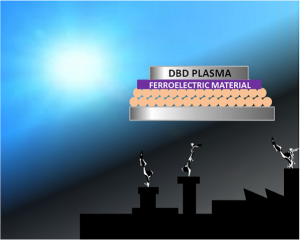Ana Gómez-Ramírez , Antonio M. Montoro-Damas , Miguel A. Rodríguez, Agustín R. González-Elipe, José Cotrino
Chemical Engineering Journal, 314 (2017) 311–319
DOI: 10.1016/j.cej.2016.11.065

In this work we have studied the plasma removal of air contaminants such as methane, chloroform, toluene and acetone in two parallel plate packed-bed dielectric barrier discharge (DBD) reactors of different sizes. Removal and energy efficiencies have been determined as a function of the residence time of the contaminated air within the reactor, the kind of packed-bed material (ferroelectrics or classical dielectric materials), the frequency and the incorporation of a ferroelectric plate onto the active electrode together with the inter-electrode ferroelectric pellets filling the gap. Results at low frequency with the small reactor and the ferroelectric plate showed an enhancement in energy efficiency (e.g., it was multiplied by a factor of six and three for toluene and chloroform, respectively) and in removal yield (e.g., it increased from 22% to 52% for chloroform and from 15% to 21% for methane). Such enhancements have been attributed to the higher energy of plasma electrons and a lower reactor capacitance found for this plate-modified configuration. A careful analysis of reaction efficiencies and electron energy distributions for the different investigated conditions and the simulation of the electric field at the necks between ferroelectric/ dielectric pellets complete the present study. Overall, the obtained results prove the critical role of the barrier architecture and operating conditions for an enhanced performance of pollution removal processes using DBD systems.

